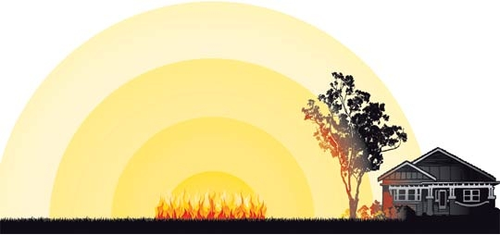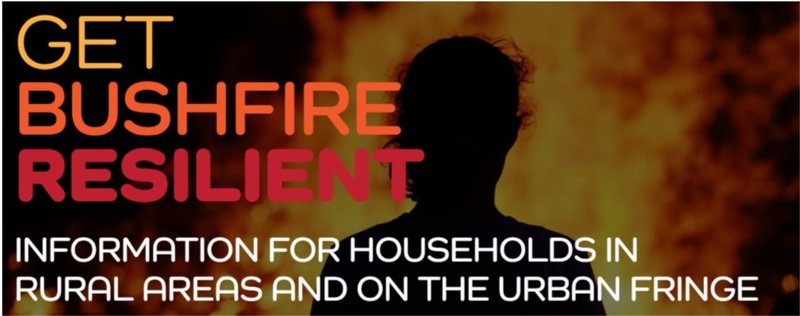
Be Bushfire Ready
Brown Hill? Are you bushfire ready?
For more detailed information access the Brown Hill Community FireAware Network web pages for:
Understanding bushfire risk to Brown Hill
Preparing yourself, your family & your property
Role of council and emergency services in the event of a bushfire
Bushfire research and more resources
Don’t be surprised – put your plan into action as soon as any bushfire weather is forecast
Keep an eye on the weather for Brown Hill (as well as your own observation):

Keep informed about FIRE RATINGS and WARNINGS for Brown Hill and surrounds:

Tune into ABC BALLARAT radio 107.9 FM on high risk days
Pre-season checklist
Before the bushfire season, it’s important to prepare your property and your family.
- Know your risk and understand what may happen and remember that the reality may be much worse
- Prepare yourself and family and your home
- Prepare your emergency kits
- Prepare and practice your plan
Know your risk - click on the appropriate video for your location and click on link in header to access comprehensive notes and more information:
If you live in the older area of Brown Hill generally south of freeway
If you live on a bush block
If you live in a sub division, generally north of freeway
Wanting more information about bushfire risk?
Do you know what radiant heat is?
Radiant heat can kill. You need to cover up, dress to protect yourself and take refuge form direct heat. In the past, people have been caught in bushfires wearing light summer dresses, shorts, singlets and even swimsuits. They usually die without the flames even touching their exposed skin. The real risks of bushfire are dehydration and heat stroke which can lead to unconsciousness and death.
If you put your hand near an open flame, an electric heater element or electric light bulb, you can feel the radiant heat it generates. Draw your hand away and the amount of heat on your skin decreases. Put something between your skin and the heat source and again, your skin immediately feels cooler. This is the key to protecting yourself from radiant heat in bushfires - distance and shielding protect you from dangerous exposure.
Bushfires usually occur on hot days. You and your family may be in shorts or swimsuits and bare feet and sandals. Remember, the deadly effects of radiant heat are increased by the amount of skin exposed to it. So as soon as you know there are bushfires in your area, cover up! Fire fighters wear protective gear to survive. So, should you. Source: What to do during a bushfire - La Trobe University

If a fire front approaches your property, it is vital that you seek protection from the radiant heat by going inside a solid structure. Your home may give some protection provided essential preparatory work has been done throughout the year. Radiant heat cannot pass through solid structures, so the best place to be as a fire passes is inside. Do not shelter from radiant heat inside your car, a swimming pool or a water tank - these do not provide adequate protection from radiant heat or smoke. Source: SA CFS
Cover up—put on protective clothing like long pants and a shirt, or overalls made from natural fibres, not sythetics. The suits firefighters wear are not simply a fashion statement. Even a woolen blanket is better than no protection. Source: Australian Academy of Science
Protective clothing is essential if you are anywhere near a bushfire. See video below. NOTE: A popular myth is to moisten or wet clothing or face masks. This may stop the item from burning, but is a serious burn hazard to a person’s skin because the moisture or steam from the wet fabric is much more likely to scold and burn a person’s skin than will dry material. Water at only 60 degrees Celsius, in contact with skin, is enough to burn it. Keep all protective clothing dry. The clothing helps shield the body from radiation and a dry mask will help reduce smoke and particle inhalation.
Source: SA CFS Fact Sheets
- Radiant heat is many times hotter than the air temperature.
- The front of a moving fire radiates up to six times more heat than its back.
- Radiant heat only radiates in straight lines and will not penetrate solid objects.
- Although it may not set a building on fire, it can crack and break windows, allowing embers to enter your home.
- Bushfires radiate a more significant amount of heat than grassfires.
Do you know what an ember attack looks like?
Footage showing what an ember attack looks like during a major bushfire. Footage from Canberra fires 2003 provided for use by CFA for community safety educational use courtesy Nine Network.
What is it like in a bushfire?
Understanding what a bushfire is like will help you choose whether to stay or go, and prepare you for the conditions you might experience if you choose to stay. Most bushfires that threaten homes burn on hot dry days with strong gusty winds.
If a bushfire is burning towards you on a day like this, it will become increasingly smoky and difficult to see, and your eyes may temporarily become reddened and sore. Breathing in heavy smoke may be uncomfortable.
As the fire gets closer, it will get darker and burning embers will begin to land around your home. The closer the fire gets, the more embers there will be.
When it gets close, you will be able to hear the loud roaring of the fire. Burning embers will rain down on your home and collect in corners and on flat surfaces. Electrical supplies may be cut off.
As the fire passes your home, the heat from the flames (radiant heat) may become unbearable, and you will need to shelter inside. By the time the bushfire has passed and it’s safe to leave the shelter of your home, the noise will have abated.
Outside it will be very smoky, and anything burning will be giving off a lot of radiant heat. This time should be used to extinguish any burning material that might ignite your home, and to continually check inside and outside your home to ensure it isn’t burning.
You will need to wear appropriate clothing to protect you from radiant heat and embers that will continue to fall for several hours. Fires look a lot worse at night than during the day, even though they are usually much milder at night. Source: Fire Tasmania publication
Why houses burn down in bushfires
Homes burn down in bushfires for one of the following reasons:
- Flames and radiant heat from burning vegetation and other bushfire fuels too close to the home cause the home to catch fire. Homes exposed to too much flame and radiant heat begin burning as the front of the bushfire passes by. Homes with too much vegetation close to them are difficult to protect from bushfire.
- Burning embers collect on combustible surfaces or blow through cracks in a home’s external cladding. Embers begin falling before the fire reaches the home, and may continue falling for several hours after the fire has passed.
Often homes only exposed to this ‘ember attack’ don’t burn down until several hours after the fire has passed. If residents are there, they can be defended successfully. Homes that are only subjected to ember attack can be defended by able-bodied people. Source: Fire Tasmania publication
Protecting your home
The biggest threats to your home in a bushfire are burning embers and radiant heat. The defendable space you create will reduce the radiant heat to acceptable levels. However, you need to make sure your home is protected against ‘ember attack’, particularly if you’ve chosen to relocate when bushfire threatens.
Embers will build up on horizontal surfaces, particularly in corners. They can enter your home through small gaps in doors and window frames, eaves, cladding and roofing. Timber decks can be ignited, particularly if embers can build up underneath them.NOTE: A house will provide some protection from a passing fire provided that you are also actively defending the house from spotfires and ignitions in and around the house. A house will only provide short-term protection, it is not a “bunker”.
Small gaps should be sealed with protection strips or non-combustible filler, and larger under-deck areas should be protected with non-flammable screens. The most vulnerable areas of your house to ember attack are under flooring, windows and the roof cavity. Measures to ember-proof your home should be taken well before the beginning of summer.
If a bushfire is burning nearby and you’ve chosen to stay:
- Listen to ABC radio for news of the bushfire (use a battery operated or car radio if the power is off), or visit the CFA website.
- Dress in a long-sleeved cotton shirt, cotton trousers (jeans), boots and a hat or helmet.
- Have a drink of water every 10 minutes to avoid dehydration.
- Clear roof gutters of leaves, and sweep or rake leaves from decks and lawns near the house.
- Block your downpipes, (a sock full of sand/soil will help) and fill your gutters with water.
- Move flammable outdoor furniture, doormats and hanging baskets away from your home.
- Turn off the mains gas supply and face the vents on any gas bottles away from the house.
- Close all doors and windows, remove curtains, and close shutters if you have them.
- Put tape across the inside of windows so they remain in place if broken.
- Fill the bath and any buckets and other containers with water, as an emergency supply source if mains pressure decreases significantly due to many people accessing mains water at the same time. NOTE: Water in the bath and basins in the house is for firefighting around the house, not for sitting in to shelter from the fire.
- Put a ladder inside to access under roof area..
- Connect garden hose or prepare your fire-fighting pump.
- Extinguish any sparks, embers and spot-fires burning on or close to your home. A hose or a wet mop is handy for this.
- Don’t stand on the roof with your hose. In bushfires, often more people are injured falling off roofs than suffer burn injuries.
- Don’t waste water wetting down roofs and walls. Use the water only for extinguishing burning material.
- Ensure all family members and pets are safe.
Source: Fire Tasmania publication
A guide to retrofit your home for better protection from a bushfire - CFA & Building Commission publication
Even if you plan to leave early the risk to your home can be lessened by undertaking the first 9 points before leaving.
Be prepared - Update your fire plan now!
Whether your intention is to leave or stay the preparation is still the same. The more you prepare the lower the risk to yourself; your family; your neighbours and your property. NOTE: A misconception is that you can prepare a house to withstand a bushfire a day or two before a fire hits. Bushfire preparations can take months. There will still be enough “jobs” to do on the day of a fire without all the other major preparations such as removing flammable material from around a house, cleaning the roof gutters, putting screens on windows, etc.
CFA VIDEO: Clearing up around your house in preparation for the fire season has never been so easy. Get on with it!
Access this link for a variety of bushfire templates and other preparation information:
No matter what your initial intention is, at the time of an event circumstances can change rapidly and you need to have already thought through and added to your plan what you will do IF your plan A is not possible i.e. you planned to leave and the roads are blocked or you are advised to “stay in place” OR you planned to stay and defend but you find the situation too much to do so – what will you do? Where will you go? What will you take?
Are you mentally prepared for a bushfire?
Preparing yourself psychologically or emotionally to cope with a bushfire is as important as the preparation of your home and surroundings. The Country Fire Service of SA have produced an excellent fact sheet that outlines the important aspects of emotional preparation for a bushfire event that residents need to consider. Access the CFS Fact Sheet here
Dr. Rob Gordon, a renowned psychologist and trauma expert, talks about disaster preparedness
Assoc Professor Kevin Tolhurst provides a few key actions for Brown Hill residents to assist them in lowering the bushfire risk to themselves and their neighbours.
If you would like more detailed information access the Brown Hill Community FireAware Network web pages for:
Understanding bushfire risk to Brown Hill
Preparing yourself, your family & your property
Role of council and emergency services in the event of a bushfire
Bushfire research and more resources
Wanting more information based on sound science?

Bushfire Resilience Incorporated (BRI) is a not-for-profit Incorporated Association. The purpose of the association is to facilitate the provision of information about bushfires to the community.Their objective is to provide high-quality, evidence-based, cost-free, best practice bushfire knowledge to people living with bushfire risk.BRI provides information to people living with bushfire risk. They have been provid free webinars since 2020 with new series being added every year since.
The topics selected are delivered by eminent subject-matter experts who provide thought-provoking, relevant, practical and evidence-based information. They want to raise awareness about risks while at the same time providing information that inspires people to take action. In addition to webinar recordings, a wide range of Bitesize content is available from their website. Access their website here.
This page has been prepared by Hazen, Brown Hill Community FireAware Network Coordinator